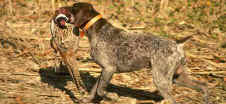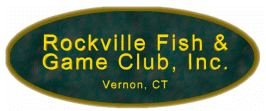 |
BIRD DOG TRAINING TIPS
TIOGA
COUNTY PENNSYLVANIA YOUTH OUTDOORS |
It's always regarded as boorish to criticize
another man's dog, no matter how lacking his field performance may be.
But, nothing in the book of field etiquette prevents a man from being
critical of his own dog. In fact, an objective appraisal of just how
your four-footed gunning partner stacks up is a shrewd move before too
much time slips rosy glasses on your memory.
Any look back should consider your dog's
overall performance as it contributed to the season's success. His
effectiveness in helping to put game in the bag is but one yardstick.
More important is the gratification provided you in how it was
collected. And that, of course, had to stem from the caliber of his
work. Such a judgment, unfortunately, must inevitably focus on the
negative aspects of his performance: those serious faults, consistent
weaknesses, or even minor errors that may have cost you valuable chances
at game or, at least, quality opportunities of which lasting memories
are made.
Reflecting on some of the most common bird dog
performance frail ties owners face, along with a few tips on coping with
them, may help you pinpoint, evaluate, and correct any your own dog
displayed last season, thus insuring improved performance next year.
A real hunt spoiler for the man who hunts with
a flushing breed is a dog that consistently hunts too fast and too far
from the gun. Nor is the pointing breed owner immune from the same
problem, which can foul things up cussingly for at least the first hour
or so a field. In both instances, over zealousness to find birds creates
the major part of the problem. But, compounding it, in most cases, is a
lack of control stemming from too little whistle training.
Certainly, you wouldn't want to dilute your
dog's bird-seeking enthusiasm. Yet, if he's to find and flush— or point
and hold, depending on breed—birds you can shoot at within range, he
must be slowed and held closer.
One way to tackle the problem is simply by
working your dog during several successive outings on a 75 foot check
cord and using your whistle and a hand signal to turn him at the precise
instant he reaches the end of the cord. Reinforce these lessons without
the check cord by working him in extra heavy cover on three or four
occasions soon after wards. Once he's complying well, you can put the
icing on the cake by getting him into a few planted quail or pigeons you
dispatch at very close range to strengthen the idea that hunting closer
to the gun produces more birds.
Almost as frustrating a problem is a pointing
or flushing dog that perennially hangs in too close to the gun. A dog
that's loathe to wander out of whisper-range of his handler assuredly
won't find any birds his owner wouldn't kick up by himself. If your
dog's inclination to stick close comes primarily from an undue
preoccupation with old or non-game bird scent, he probably needs only to
get into birds quicker and more frequently.
Should his actions reflect a natural timidness
or trace to heavy handedness, however, he'll need scads of encouragement
to transcend his fear of leaving your protective or too watchful eye. In
that case, buttressing your dog's self confidence must be achieved by
stimulating his native instincts and amplifying the notion that hunting
is fun, not drudge-work. Normally, the shortest route to that goal comes
via a total suspension of discipline in the field, letting him behave
like a puppy for a while, and finding and chasing birds at will.
Sometimes, too, a brief moratorium on shooting can speed results,
particularly if exposure to too much gunfire too early may have
contributed to your dog's timidity.
Breaking point after a minute or two is another
not uncommon de fect in pointing dogs aged under a year and a half. Such
youngsters customarily are merely getting so hopped up on bird scent
that their enthusiasm takes them to the breaking-point —yes, the pun
definitely is intended, and meant to underscore our point. Their
spirited interest in birds, combined with inexperience in the
collaboration required between themselves and the gun, call for a
two-fold remedy.
First, a bit of staunching is in order as you
encourage your dog to hold each point a little longer than the previous
one. For starters, a 50-foot check cord and a few plant ed birds are
needed. What you're trying to do is get your dog on point, under
controlled conditions, so you can make sure he doesn't break before you
reach him. Then, by physically handling him, stroking him reassuringly
and gently nudging his hindquarters forward, you'll be staunching his
points and simultaneously increasing their duration. Secondly, you must
help him link the holding of a staunch point with the gun's arrival and
ultimate bring ing of the bird to ground after the flush. Only by
killing birds over his points and not shooting at any of those that
flush wild or that he bumps, even accidentally, can you be sure the
message will get across.
Costing uncountable chances for probable
killing shots is the pointing dog that perennially crowds his birds and
simply won't respond to the whoa command. Really two distinct and
separate transgressions, the first one can sometimes be avoided by
correcting the latter. Invariably, af ter establishing point, the
offending dog cannot resist taking two or three extra steps closer to
the quarry, shortening the string just enough to push a spooky bird or
covey skyward well out of range of the gun.
The culprit cause of such behavior can many
times be traced to too much work exclusively on planted birds. Since
they can be dizzied and set to hold tight in heavy cover, such plants do
nothing to discourage a dog from approaching much closer than wild birds
would ordinarily permit. But, ironically enough, planted birds can be
used to cure the problem.
"Flight-planting," my terminology for
releasing a bobwhite or Coturnix quail from my gloved hand, enables the
bird to air wash any man-scent from itself as it flies a short distance
before landing in cover. Not only does this method leave the bird
smelling more like a wild bird, but it enables it to deposit some
natural ground scent as it walks around seeking a hiding place.
Then, waiting about l0 minutes after releasing
a couple of birds out of hand, you can work your dog on a check cord
into the area where the birds landed. At the very first sign he's winded
body scent, whoa him by voice and, if necessary, halt him with the check
cord. Should he try to crowd the bird—even by taking a single step
forward—stop him with the cord as you repeat the whoa command.
Repetition should eventually bring you success. But even if your dog
still evidences a strong inclination to creep on his birds, your
reinforcement of his instant obedience to the whoa command should
prevent him from crowding birds whenever he's in hearing distance.
Whether flushing or pointing breed, the gun dog
that fetches to his owner's hand a partially chomped game bird risks
bringing down the wrath of hell on his deserving rump. Few irritations
sur pass delivery of a hard won feathered prize all soggy and
tooth-punctured and barely salvageable for the table— the hapless
victim of "hardmouth."
If your dog has displayed even the slightest
tendency to crunch on his birds, don't delay in recognizing and dealing
with the problem. It doesn't ever get better, only worse. What you need
to do is discourage his chomping and elicit a more gentle carry, using
one of several different methods.
Long a favorite cure for "hard mouth"
is the crisscrossing of nails, meat skewers, or knitting needles inside
a game bird or pigeon. The point is obvious, and that's precisely what
the errant dog receives the first time he crunches the booby-trapped
bird. He may elect to crunch an additional time or two, but seldom much
more than that before realizing that these birds bite back if not
handled very gingerly.
Naturally, if he refuses the pickup after being
"nailed" the first time, you'll have to force the issue,
gently or more firmly, depending on your dog's temperament. A bold dog
is usually easier to correct with this method, and a somewhat timid dog
is, of course, always more difficult.
For the latter type, there's a slow er, more
genteel method you might try, one recommended in my book, The Complete
Guide To Bird Dog Training, published by Winchester Press. It consists
of using only birds that have been well chilled in the refrigerator.
Since the bird's flesh is very cold and somewhat stiff, crun ching down
on them will prove to be discomforting to your dog's teeth. A tender
pickup and carry elimi nates this discomfort, something your dog will
discover very quickly.
A week or so of retrieving only
"fridge" birds and he can be switched over to a live bird
safely ensconced in a bird sleeve surround ed by a harness with blunted
spikes. After a few such retrieves each session for another week, you
can begin having him fetch dead birds again.
If he returns to his bad habits, you'll have to
return to using cold birds and alternating them with live, sleeved birds
in harness until he proves to you that he gets the message permanently.
Certainly, as you look back on past experience,
and zero in on any performance frailties your dog dis played, you won't
fail to remember the positive aspects of his hunting efforts, too. Take
the time to reflect on the good chances he provided you to put birds in
the bag, and then try to envision how much less you'd have enjoyed any
of those hunts had he not been along with you. |
